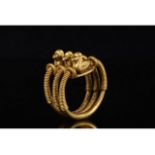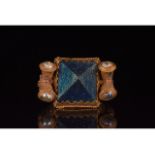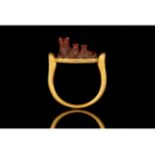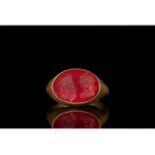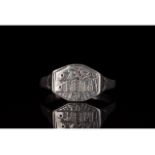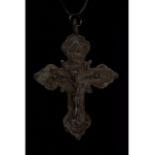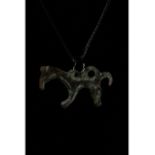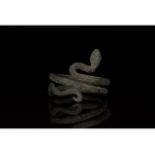Refine your search
Estimate
Category
- Arms, Armour & Militaria (123)
- Jewellery (90)
- Greek, Roman, Egyptian & Other Antiquities (39)
- Sculpture (20)
- Collectables (15)
- Scientific Instruments (14)
- Glassware (13)
- Salvage & Architectural Antiques (12)
- Metalware (10)
- Coins (9)
- Ceramics (4)
- Vintage Fashion (4)
- Musical Instruments & Memorabilia (3)
- Silver & Silver-plated items (2)
- Sporting Memorabilia & Equipment (2)
- Textiles (2)
- Books & Periodicals (1)
- Stamps (1)
- Tools (1)
- Wines & Spirits (1)
- List
- Grid
A subscription to the Price Guide is required to view results for auctions ten days or older. Click here for more information
C. 100-50 BC. Roman. Very rare bronze Montefortino bronze helmet with rounded bowl, folded brim and projection on the top for attaching a plume. T...
C. 200 BC. Celtic iron age. Gold ring comprising three hoops with filigree-decorated shoulders, joined by a bezel surmounted by three stylised duc...
c. 323-31 BC. Greek Hellenistic period. A stunning gold ring with a rounded band, petal-shaped shoulders and circular plate bezel featuring an eng...
1100-1300 AD. Byzantine. Gold cross with four round-section arms of equal length set around a garnet cabochon; the space between each of the arms ...
c. 1100-1300 AD. Byzantine. Stunning gold ring with unusual tear-drop shaped hoop, double trumpet-shaped projections with pearl settings on each s...
c. 900-1100 AD. Viking Age. Twisted gold ring comprising of circular hoop separating at the shoulders into three, interwoven strands. This ring wa...
c. 323-31 BC. Greek Hellenistic period. Gold ring with D-shaped hoop and flattened, elliptical plate bezel bearing an engraved depiction of a two-...
C. 600-700 AD. Merovingian. Magnificent gold ring with ribbed, D-shaped hoop with baubles on the shoulders and projecting, cross-shaped bezel with...
100-300 AD. Roman. Solid gold ring with circular hoop, thick shoulders decorated with vegetal scroll motifs and oval-shaped scalloped bezel with a...
c. 900-1110 AD. Viking Age. Gold ring comprising a circular hoop with ribbed shoulders and a double plate bezel. The bezel plates, which are sligh...
1100-1300. Byzantine. Stunning gold cross with rounded, ribbed suspension loop, gold terminals and crosspiece with elaborate filigree decoration a...
100-300 AD. Roman. Gold ring with circular hoop, ribbed shoulders, round, flattened bezel with scalloped pedalling on the shoulders and red gemsto...
c. 500-200 BC, Classical down to Alexander the Great and Hellenistic periods. This beautiful two-part Chalcidian helmet features a high-crested br...
100-300 AD. Roman. Gold pendant with rounded ribbed suspension loop and elliptical medallion; the medallion features a cameo bust of a female figu...
1550-1070 BC. Late New Kingdom. Gold ring with D-shaped hoop and projecting shoulders; a rectangular plaque between the two shoulders forms a supp...
1100-1300 AD. Byzantine. Stunning gold ring with circular hoop and attached elliptical bezel with crimped edges and a garnet cabochon setting; a s...
100-300 AD. Roman. Gold ring with D-shaped hoop and elliptical bezel with red gemstone intaglio setting. The intaglio depicts a standing female fi...
c. 211 AD. Roman. Gold ring comprising circular hoop and elliptical bezel with carnelian intaglio setting showing the confronted figures of Caraca...
BYZANTINE SILVER GILT CROWN RING
C. 1100-1300 AD. Byzantine. Gilt silver with ring with circular, ribbed hoop and elaborate domed crown bezel. Byzantium was justly famous for the ...
300-450 AD. Late Roman. Silver ring with circular hoop and octagonal bezel bearing a rare incised camp gate motif topped by three standards. Camp ...
1200-1500 AD. Later Crusader period. Silver ring with circular hoop and flattened, octagonal bezel which bears incised decoration depicting vegeta...
BYZANTINE SILVER RING WITH BIRD
C. 1100-1300 AD. Byzantine. Silver ring with circular hoop, floral decoration on the shoulders and a trumpet bezel bearing an incised bird motif. ...
Ca. 700-1100 AD. Viking Age. This beautiful silver ring comprises a circular hoop and a round bezel with incised linear symbols, possibly runes, a...
Ca. 100-300 AD. Roman. A restrung necklace of Roman beads comprising cylindrical carnelian beads and spherical metallic spacers. The vibrant red b...
Ca. 100-300 AD. Roman. A restrung necklace of Roman beads comprising multiple opaque and transparent sub- spherical, tubular and rectangular glass...
Ca. 100-300 AD. Roman. A restrung necklace of Roman beads comprising multiple opaque and transparent sub- spherical, tubular and rectangular glass...
Ca. 100-300 AD. Roman. A restrung set of earrings and a necklace of Roman beads comprising multiple opaque and transparent sub-spherical, glass, g...
C. 1100-1300 AD. Byzantine. A gorgeous pair of gold pendant earrings each comprising a rounded hoop from which hangs a net of sixteen rings which ...
100-300 AD. Roman period. An elaborate pair of gold earrings each comprising (from top to bottom): a rounded suspension loop connecting to a circu...
100-300 AD. Roman period. An elaborate pair of gold earrings each comprising (from top to bottom): a circular hoop flanked on each side by two arc...
c. 323-31 BC. Greek Hellenistic period. A pair of beautiful gold earrings, each comprising an oval-shaped hoop with hooked attachment and a semi-c...
Ca. 700-1100 AD. Viking Age. A thick cast Viking era silver 'Omega' penannular brooch with circular hoop, rounded section, a broad, arrow-shaped p...
Ca. 700- 1100 AD. Viking Era. A fine bronze Viking era 'Omega' penannular brooch with hemi-spherical blue gems set into the terminals, a circular ...
Ca.900-1100 AD. Viking Age. Bronze amulet comprising a longboat with stylised dragon’s-head prow and stern with carefully cast features and text...
Ca. 700-1100 AD. Viking Age. A collection of four cast Viking era 'Omega' penannular brooches, each with a circular hoop, rounded section, a broad...
100-300 AD. Roman. Bronze brooch comprising two rectangular bars joined by two stylised leaping dolphins, which feature carefully incised fins and...
100-300 AD. Roman. A silvered bronze brooch with a large, openwork pelta-shaped head plate, circular bow and flaring terminal; a coiled spring and...
ROMAN BRONZE HORSE BROOCH
100-200 AD. Roman. Bronze brooch, depicting a horse with a fine head shown in profile. The catch-plate and pin are both fully preserved. Brooches ...
C. 300 BC. Celtic Iron Age. Bronze omega brooch with circular hoop, rounded terminals and well-preserved loop pin. The metal of the brooch now dis...
Ca. 700-1100 AD. Viking Age. A thick cast Viking era silver 'Omega' penannular brooch with circular hoop, rounded section, a broad, arrow-shaped p...
C. 200 BC. Celtic Iron Age. Bronze belt buckle comprising a hemispherical plate with incised D-shaped frame made from two rows of confronted trian...
100-300 AD. Roman. Gold medallion comprising a circular suspension loop with ribbed decoration on the exterior and an oval-shaped medallion with s...
100-300 AD. Roman. Gold lunar medallion comprising arched arms with sub-triangular sections; at the top of the arch is an inverted heart-shaped ap...
1300-1500 AD. Late medieval. Gold pendant in the form of a Latin cross formed from six oval-shaped cabochon emeralds in gold settings; the edge is...
C. 1100-1300 AD. Byzantine. Gold openwork pendant with rounded suspension loop featuring exterior ribbing, from which hands an almond-shaped penda...
MEDIEVAL BRONZE CROSS PENDANT
1000-1500 AD, Medieval Crusader period. A large bronze pendant in the form of a Latin cross with rounded arms and a suspension loop at the top. Th...
BRONZE AGE "CAGE" PENDANT
C. 600 BC, Bronze Age Large bronze cage pendant. The pendant's openwork biconical shape is formed of a combination straight and curved bars of bro...
MEDIEVAL BRONZE CROSS PENDANT
1000-1500 AD, Medieval Crusader period. A large bronze pendant in the form of a Latin cross with scalloped edges and a rounded suspension loop at ...
BRONZE AGE ANIMAL AMULET
C. 600-800 BC. Bronze Age. Cast bronze zoomorphic amulet comprising an animal, perhaps a horse, shown in profile, with dual circular suspension lo...
BRONZE AGE ANIMAL AMULET
C. 600-800 BC. Bronze Age. Cast bronze zoomorphic amulet comprising an unidentified animal, shown in profile, with a circular suspension loop at t...
BRONZE AGE RAM AMULET
C. 1000 BC. Hallstatt Culture. Cast bronze zoomorphic amulet in the form of a ram with short snout, long curving horns, clearly delineated legs an...
MEDIEVAL BRONZE CROSS PENDANT
1000-1500 AD, Medieval Crusader period. A large bronze cross pendant comprising four arms; the horizontal arms are rectangular while the vertical ...
1100-1300 AD, Medieval. A silver ring with a circular hoop and flattened octagonal bezel featuring an incised prancing gryphon motif. The griffin,...
VIKING SILVER AND NIELLO RING
700-1100 AD, Viking Age. Silver ring with D-shaped hoop and flattened, square bezel bearing an abstract symbolic nielloed design. The design takes...
VIKING SILVER COILED RING
700-1100 AD, Viking Age. A silver coiled ring with trailing ends and flaring central plate bearing an incised scale motif, intended to evoke the f...
1100-1300 AD, Medieval. Silver ring with circular hoop and flattened, round bezel featuring incised decoration including a stylised beast, possibl...
100-300 AD. Roman. Bronze ring with thick, circular hoop and flattened, disc-shaped bezel bearing an incised stylised thunderbolt formed from inte...
ROMAN BRONZE SNAKE SHAPED RING
100-300 AD. Roman. Bronze snake-shaped ring with carefully modelled head, incised scale details and curling tail. Snakes were associated with the ...
1100-1500 AD, Medieval. Bronze signet ring with circular hoop and flattened, oval-shaped bezel featuring an engraved horse and rider motif within ...
700-1100 AD, Viking Age. A heavy silver twisted bracelet comprising several strands of silver woven together with tapering terminals meant evoke t...



